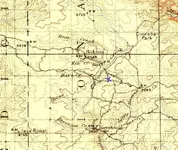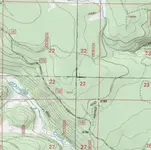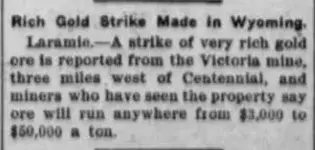The Lost Downey Mine
The beginning of our research into this lost mine began with a very brief mention about how Col. Downey was offered $100,000 for his mine and refused to sell. He later told area residents that the mine was played out, which they refused to believe.
My findings are the Downey Lode is along Douglas Creek north of Douglas City and the Keystone Mine. It was near the Fanchon Lode. I am including a map I created with a blue x marking the site. The map does show old roads that should be pretty over grown today. My map was created using info from “The Medicine Bow Mining Camps” by Mel Duncan page 108. The site was at Last Chance Gulch, Section 10, along Moore’s Creek. This was according to a chart by Mel Duncan from 1878. It was a quartz lode.
Colonel Stephan Downey was involved with various mining properties and Wyoming politics and there is much about him in the early history books. What appears to have caused the story of the Lost Downey Lode was the Centennial Mine otherwise known as the Centennial Vein on Centennial Ridge (discovered in 1875). Downey ended up with the Centennial eventually under his control and the following year select ore was assayed in Denver at over $46,000 a ton in gold and also contained $270 in silver per ton as well. News of the rich ore made the front page of the New York Times!
It took time to get a 5-stamp mill set up and then the spring run-off, slowed and stopped and winter arrived. All that could be done was to stock pile ore. The Centennial Mining Company incorporated and capital of $500,000 was set with 5,000 shares at $100 each. By June 1876 Stephan Downey was making plans for an improved stamp mill. By summer the stamp mill was running both night and day and Centennial was laid out. The name was selected due to the 100-year anniversary of the founding of our country. At this point the mill crushed 7-8 tons of ore per day, producing $150 to $200 in gold each day of operation.
In 1877 the shaft following the rich vein faulted and the miners were met by a granite wall! Two other shafts were dug in hopes of hitting the rich ore. The first hit the granite wall, the last hit the original shaft that was filled with debris and resulted in failing to reach the rich vein of ore. Work stopped at the end of August 1877. The rich ore was limited and the mill had nothing to process. All available ore that could be run amounted to only $740 in gold while the costs amounted to over $3,500. This ended the Centennial Mine and cost Downey over $1,100 from his own pocket.
Downey then focused his efforts on the Keystone Mine near the Last Chance Diggings. In 1879 Reuben Ferguson reported that he discovered the lost Centennial vein. But this turned out to be a false hope. Downey was able to obtain investors for the search for the lost Centennial vein (1880-1881), still this newly invested money failed to produce the lost vein. There are some claims that besides losing the vein, Downey lost his mind. This could be explained by the following: residents of Centennial claimed that the owner could be heard blasting day and night on the ridge trying to find the lost vein.
Over the years, prospectors have ventured to Centennial Ridge to rediscover the lost Centennial vein. Their efforts have failed, but other smaller discoveries were made in later years. With the higher price of gold, the region draws weekend prospectors into the Medicine Bow Mountains once more.
Conclusion: The Lost Downey Lode is really the Lost Centennial Vein the location is at the site of the old mine, except once it faulted it was never found again. No doubt the source of the rich ore worth $46,000 per ton in 1876 is still there, just deep underground somewhere.
The included map is the location of what was known as the Downey Lode on Douglas Creek. His quartz lode is marked with a blue x on this map from around 1906. Old roads might still be followed with a 4 wheeler into the region. The site is above Douglas City and the old Keystone Mine.







